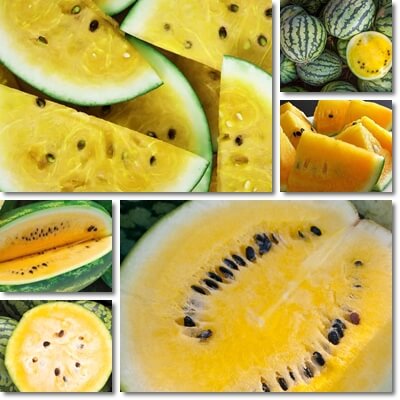Why are some watermelons yellow inside? Nowadays we’re quite used to seeing the same fruit in a variety of colors such as green, yellow, pink and red apples or white, red, rose and purple grapes.
However, we’re not that used to seeing watermelon colors other than pink and red. But many, of not most fruits come in a variety of colors, including watermelon.
Aside from the more common pink and red-fleshed watermelon varieties, there are also orange, green and even yellow-fleshed watermelons. But why are yellow watermelons yellow?
Are yellow watermelons genetically modified?
No, yellow watermelons are not genetically modified. In fact, yellow watermelons are naturally-occurring, that is, they evolved to their present color naturally, through human cultivation paired with unintentional and/or intentional selective breeding.
According to reports, the ancestor of the modern watermelon was a fruit very much resembling present watermelons, but with a hard, pale, whitish green, rather unpalatable flesh.
Since it stored water, it was deemed a precious commodity and picked up for cultivation. Over time, human cultivation of the fruit naturally resulted in the modern watermelon varieties with sweet, juicy and crisp pink, red, salmon, white, orange and yellow flesh.

What is yellow watermelon crossed with?
There are well over 1000 different cultivated varieties of watermelon. The most popular varieties belong to the Citrullus lanatus species and are sweet, crisp and extremely juicy.
But to get to their present form, color and taste, they were once cross-bred from what would now be dubbed as inferior watermelons until traits such as yellow flesh color (or pink, red or orange), sweetness, juiciness and crispness were obtained to the desired level.
Why are yellow watermelons yellow?
Yellow watermelons are yellow because they are low in a pigment called lycopene and high in pigments called xanthophylls. Lycopene is a pigment and carotenoid antioxidant that gives pink and red-fleshed watermelons their characteristic color (and tomatoes, guava, grapefruit and red carrots). Yellow watermelon has very low levels of lycopene. Instead, it’s higher in yellow xanthophylls, notably neoxanthin, but also violaxanthin, neochrome and lutein, hence its yellow flesh color.
By comparison, what makes watermelon red inside is a high content of red lycopene pigments which dominate the color palette. Similarly, what makes orange watermelon orange inside is a high content of orange beta-carotene which dominates the pigment profile resulting in the specific flesh color.
Are yellow watermelons rare?
Only in the Western world are yellow watermelons rare. Throughout Africa and Southeastern, Eastern, Southern and Central Asia it’s actually fairly common to see yellow watermelons alongside pink, red and even salmon, orange and green-fleshed watermelons.
Watermelons were originally cultivated in northern Africa, then cultivation extended to the entire continent and other desert and arid regions where the fruit’s rich water content was sought after. But considering intensive cross-breeding efforts that have resulted in honey-sweet, crisp and extremely juicy varieties, the yellow-fleshed watermelon is rapidly gaining popularity in the West.

What are yellow watermelons called?
The generic name is yellow watermelon. Some people may refer to the fruit as yellow flesh or yellow meat watermelon or yellow-fleshed or yellow-meated watermelon. Yellow watermelons are also called by their cultivar name, when said name is known. For example: Honey heart, Yellow moon and stars watermelon, Mountain sweet, Early Moonbeam, Yellow buttercup, Hopi yellow, Yellow baby, Petite Yellow, Yellow doll watermelon etc.
What does a yellow watermelon taste like?
There are actually quite a few different cultivars of yellow watermelon which range in appearance and flavor profile. For the most part, yellow watermelons taste sweet, sweeter than red watermelons. Yellow watermelons have pregnant honey flavors with a fruity finish and no acidity. They’re crisp and extremely juicy, with a soft and dense flesh. Compared to red watermelons which are stringy, yellow watermelons are not stringy at all.
Is yellow watermelon healthy?
If anything, yellow watermelon is a healthy fruit to eat. As indicated by its color, it is a source of lutein and other xanthophyll antioxidants which hold benefits primarily for eyesight. Naturally sodium-free and a source of potassium and other electrolytes, yellow watermelons are good for high blood pressure. Source of vitamin C, the yellow-fleshed fruit promote healthy gums and teeth and provide anti-inflammatory benefits.
Find out more amazing benefits of eating yellow watermelon.
Where can you find yellow watermelon?
Yellow watermelon peak season is mid-summer, July through August, although the variety is available as early as mid-June and as late as mid-September. This means that, right now, yellow watermelon is in full season so chances are you can easily find it at your local supermarket or hypermarket or at farmer’s markets. If you’re in India, Indonesia, Malaysia or Southeast Asia in general, or anywhere warm, it’s likely available at local markets or street vendors everywhere.
